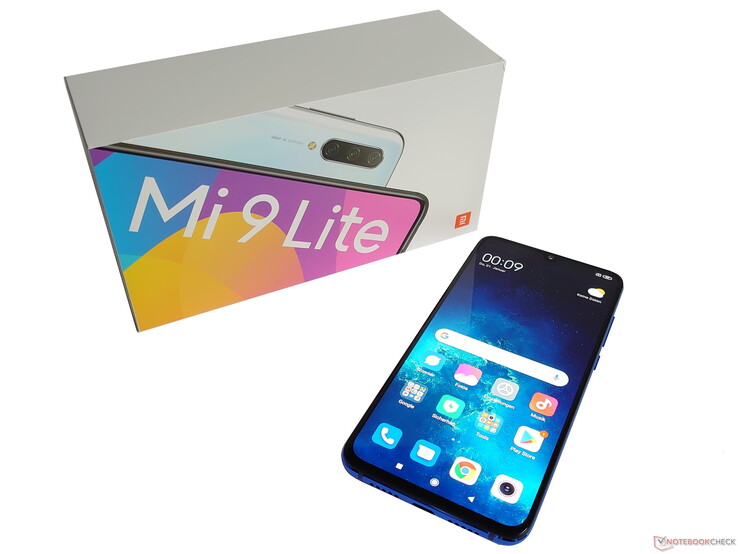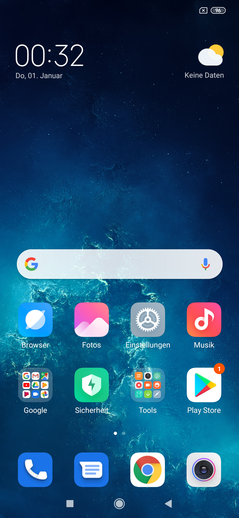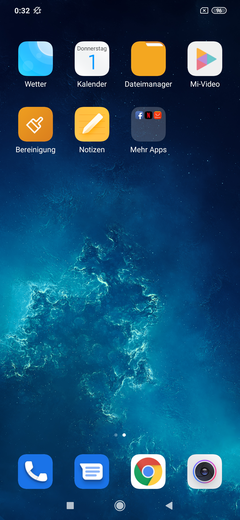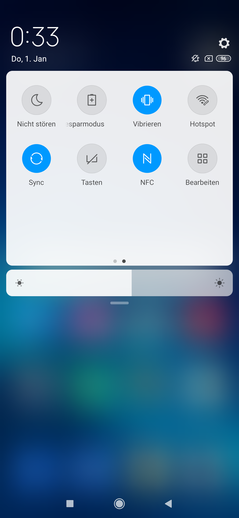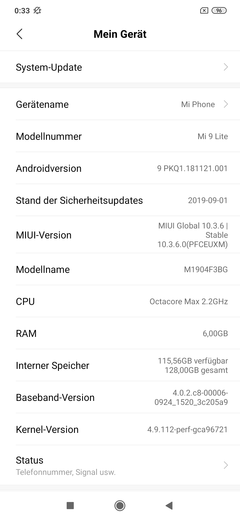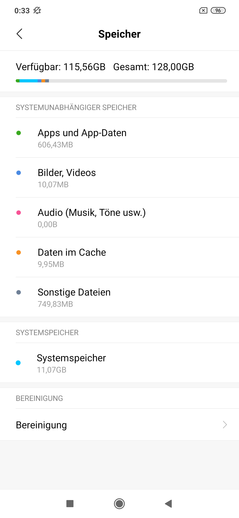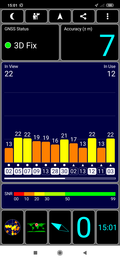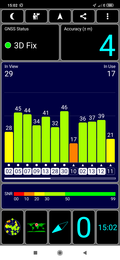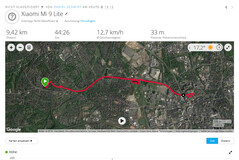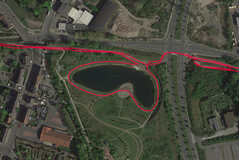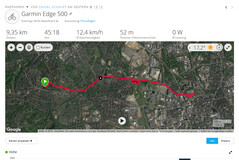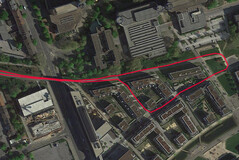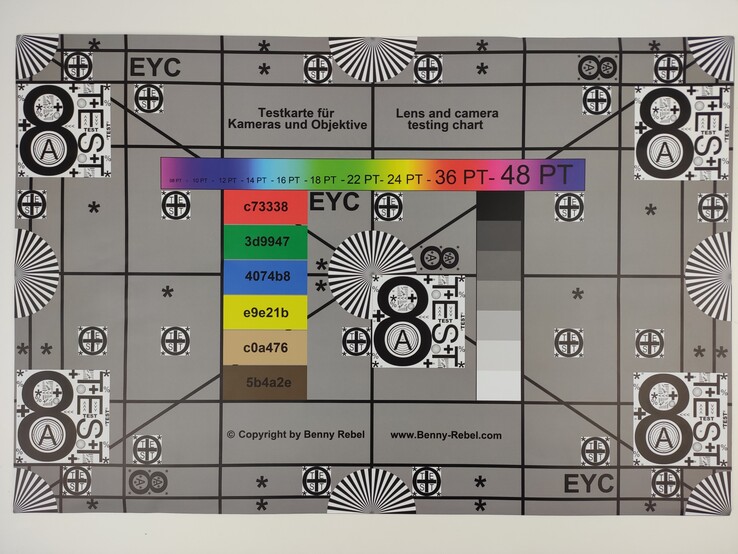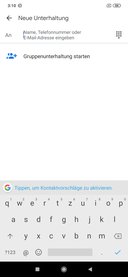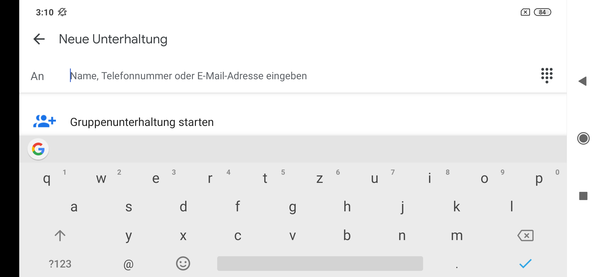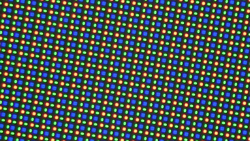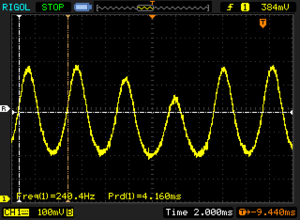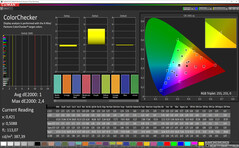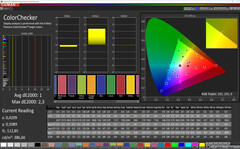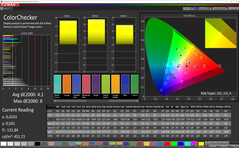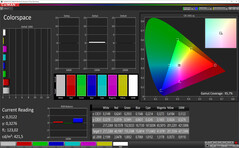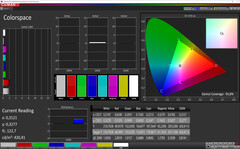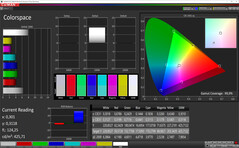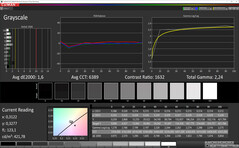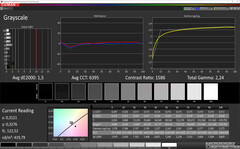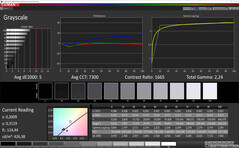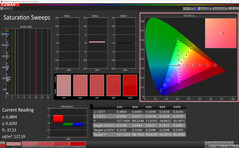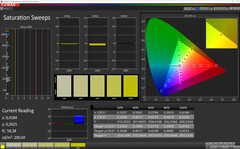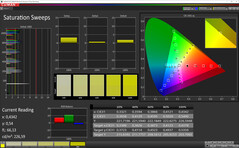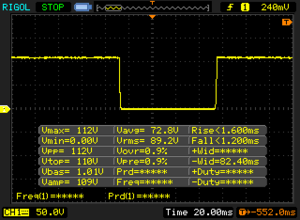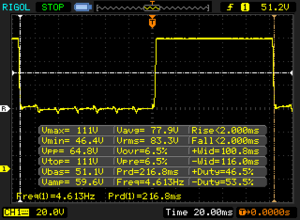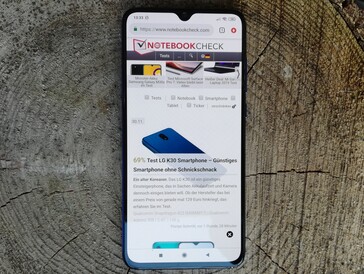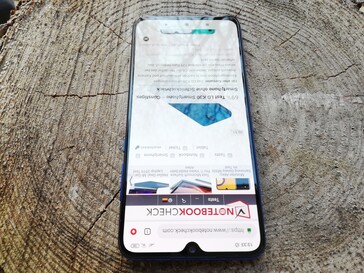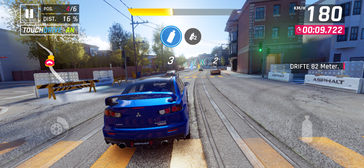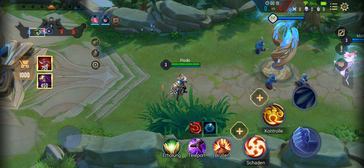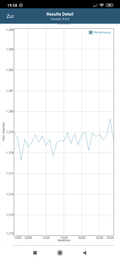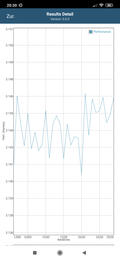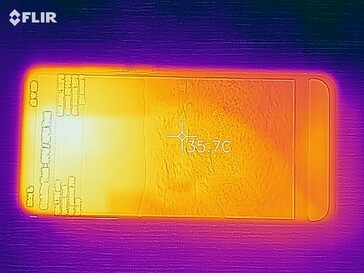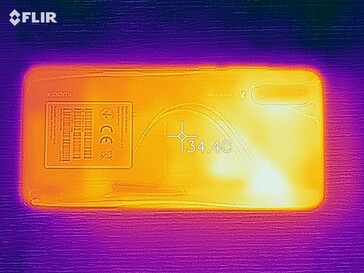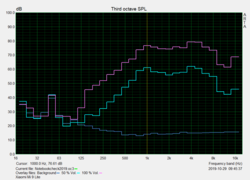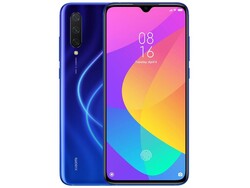Xiaomi Mi 9 Lite Smartphone Review: Big Bang for the Buck
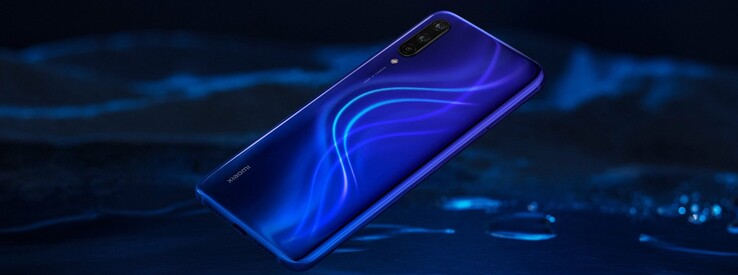
Xiaomi is very ambitious with its current generation smartphones. Their A3 was recently referred to as “price-performance king”, and our verdict for the Xiaomi Redmi Note 8 was that overall it turned out to be a well-rounded solid device. Considering their low prices of just slightly north of $200 the company has managed to raise the budget smartphone bar quite dramatically by forcing the competition to up the ante and equip their budget phones with the latest technology in return as well.
The Mi 9 Lite is yet another Xiaomi smartphone priced around $250 fighting for the customer’s attention. It is equipped with a Qualcomm Snapdragon 710 SoC, an Adreno 616, GPU, 6 GB of RAM, and 128 GB of UFS 2.1 storage. Quite a challenge for its competitors, which we have listed below. Keep in mind that you can add additional devices to each table.
Vergleichsgeräte
Rating | Date | Model | Weight | Drive | Size | Resolution | Price |
|---|---|---|---|---|---|---|---|
| 80.5 % v7 (old) | 12 / 2019 | Xiaomi Mi 9 Lite SD 710, Adreno 616 | 179 g | 128 GB UFS 2.0 Flash | 6.39" | 2340x1080 | |
| 79.8 % v7 (old) | 04 / 2019 | Samsung Galaxy A50 Exynos 9610, Mali-G72 MP3 | 166 g | 128 GB UFS 2.1 Flash | 6.40" | 2340x1080 | |
| 78.6 % v7 (old) | 11 / 2019 | Nokia 7.2 SD 660, Adreno 512 | 180 g | 64 GB eMMC Flash | 6.30" | 2340x1080 | |
| 77.3 % v7 (old) | 10 / 2019 | HTC Desire 19+ Helio P35 MT6765, PowerVR GE8320 | 170 g | 64 GB eMMC Flash | 6.20" | 1520x720 | |
| 78.4 % v7 (old) | 11 / 2019 | Motorola Moto G8 Plus SD 665, Adreno 610 | 188 g | 64 GB eMMC Flash | 6.30" | 2280x1080 |
Case
The Mi 9 Lite contains a solid metal frame and a glass rear cover. The latter is playfully colorful and more or less wavy, depending on viewing angle. Overall, the build quality is very good and we were unable to find any flaws or frailties. Our review model was Aurora Blue. Other available colors include Onyx Gray and Pearl White.
In direct comparison with its competitors regarding weight and footprint the Xiaomi Mi 9 Lite turned out to be average.
Connectivity
Thanks to a Qualcomm Snapdragon 710 SoC, a Qualcomm Adreno 616 GPU, 6 GB of RAM and 128 GB of UFS 2.1 storage the Xiaomi Mi 9 Lite performed very smoothly overall. Storage can be expanded via microSD cards of up to 256 GB, according to Xiaomi. However, by doing so you will lose the secondary SIM slot since it can take either a SIM or a memory card but not both. Speaking of SIM cards, both SIM slots support LTE yet we failed to locate VoLTE and Wi-Fi calling in the smartphone’s settings.
In addition to its notification LED, the Mi 9 Lite also features an infrared port. Its Camera2 API supports the “Full” mode, and video streaming services such as Prime or Netflix can be enjoyed in FHD thanks to support for DRM Widevine L1. Wired connectivity is brought to you via a USB-C port connected to a USB 2.0 bus. A 3.5-mm headphone jack allows for external analog headphones or speakers.
Software
Out of the box the Xiaomi Mi 9 Lite runs Xiaomi’s own MIUI Global 10.3.6 skin atop of Android 9 with security patches as of September 1, 2019. The user interface closely resembles stock Android, and its main modifications include new icons as well as a rearranged settings menu. Preloaded third party apps, such as AliExpress or Facebook, can be easily uninstalled. Offloading apps onto SD card is not supported.
Keep in mind that changing some settings requires an active internet connection as well as a Mi account. These include settings that can easily be changed offline and without a user account on competing smartphones.
Communication and GPS
Supported cellular services include 2G, 3G, and 4G/LTE Cat 12 with upload and download speeds of up to 100 and 600 Mbps, respectively. Supported near-field wireless communications protocols include NFC, Bluetooth 5.0, and Wi-Fi 5 aka 802.11 a/b/g/n/ac.
When benchmarked while connected to our Linksys EA8500 reference router the Wi-Fi modem managed great average transfer speeds of 347 and 296 MB/s downstream and upstream, respectively. Accordingly, the Mi 9 Lite gets to share first place with the Nokia 7.2.
| Networking | |
| iperf3 transmit AX12 | |
| Nokia 7.2 | |
| Xiaomi Mi 9 Lite | |
| Samsung Galaxy A50 | |
| Motorola Moto G8 Plus | |
| HTC Desire 19+ | |
| iperf3 receive AX12 | |
| Xiaomi Mi 9 Lite | |
| Nokia 7.2 | |
| Samsung Galaxy A50 | |
| HTC Desire 19+ | |
| Motorola Moto G8 Plus | |
We use the GPS Test app to test a smartphone’s satnav capabilities. Supported location services include GPS, GLONASS, Galileo, and Beidou. Outdoors, the Xiaomi Mi 9 Lite managed a GPS accuracy of 4 m (~13 ft). Indoor accuracy was slightly reduced at 7 m (~23 ft).
On our usual bike tour around the block the Mi 9 Lite’s recorded track was very similar to the Garmin Edge 500’s. Corners are recorded fairly accurately and we only noticed minor deviations on long straights. Overall, the device is definitely well usable for everyday navigation.
Telephony and Call Quality
Xiaomi opted for Google’s default telephony app, which offers quick access to a numpad for manual entry of phone numbers, favorites, and contacts. Volume is fairly high during phone calls, and thanks to a decent ambient noise filter we had no issues in noisy surroundings either.
Cameras
The Xiaomi Mi 9 Lite’s main camera offers three sensors with 48, 8, and 2 MP, respectively. The main half-inch large sensor with a 0.8µm pixel width is equipped with an f/1.8 lens. The front-facing camera features a 32 MP sensor with the same 0.8 µm pixel width and an aperture of f/2.0. It allows for decent portrait photos with slightly pale colors. Fine details and textures remain well distinguishable. The camera app is fairly limited in terms of quality settings. While various lighting scenarios can be simulated and filters and beauty filters can be applied retroactively, the front-facing camera does not support a professional mode with manual settings.
The main camera takes photos rich in detail with popping colors. Individual objects remain well distinguishable when zoomed-in and surface textures are even and homogenous. Nevertheless, a slight graininess is visible. At close range test subjects are crisp and not overexposed even in backlight. Fine details and textures remain recognizable and distinguishable. In low-light situations the camera was capable of capturing our test subject without creating too many dark underexposed areas in the shot. Unfortunately, the test subject turned out blurry and not particularly rich in detail. The camera app allows for taking photos with a 2x optical zoom or an ultra-wide angle, and in addition to a night mode, it also supports a professional mode allowing for manual adjustment of white balance, focus, exposure, and ISO.
The video quality is comparable to photo quality. Minor shake is eliminated thanks to optical image stabilization, and videos can be either H.264 or H.265-encoded. Quality presets include:
- 4K at 30 FPS
- 1080p at 60 FPS
- 1080p at 30 FPS
- 720p at 30 FPS
Other features include time lapse, slow motion, and capturing short videos of up to 15 seconds.
We use the ColorChecker Passport to test for a smartphone camera’s color accuracy. In the case of the Xiaomi Mi 9 Lite colors are mostly brighter than expected, except for yellows and blacks, which are darker than they should be. The ColorChecker Passport was no longer visible when we reduced the illumination to one lux.
The test chart was captured very well under normalized lighting conditions. Fine details and textures remain recognizable, and a slight paleness can be noticed in the lower corners. With illumination reduced to one lux the chart was captured rather poorly.
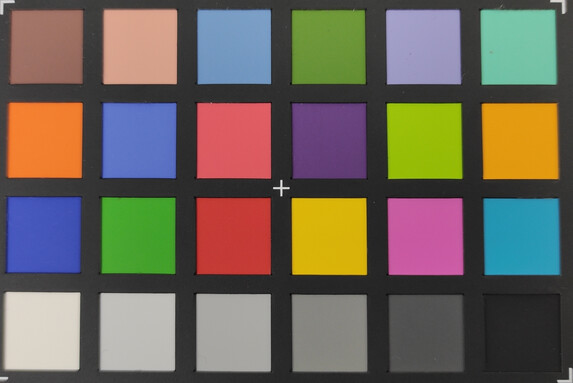
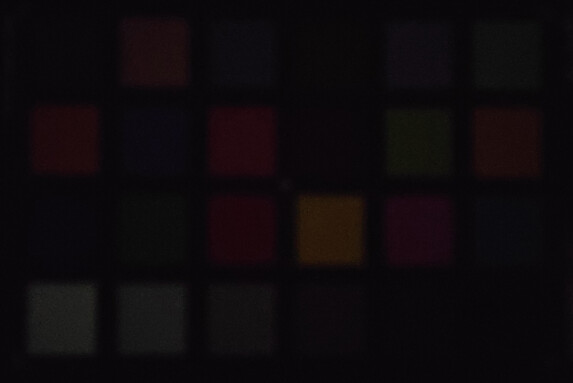
Accessories and Warranty
In addition to the Xiaomi Mi 9 Lite itself, the box also includes a modular charger with matching USB-C cable, a SIM tool, and a protective case made of silicon. Xiaomi does not offer any other additional model-specific accessories. However, smart bracelets or Bluetooth headphones compatible with the Mi 9 Lite are available for purchase.
Xiaomi sells its smartphones with a 12-month limited warranty.
Input Devices & Handling
The keyboard application chosen by Xiaomi is Google’s default keyboard, which allows for fast text input and can be individually customized to your liking. The touchscreen was quick to react. Unfortunately, its drag resistance during drag and drop operations was slightly too high for comfortable input. The orientation sensor worked reliably and well.
The device features an in-screen fingerprint reader. It was a bit slow to react and took about a second to unlock the phone and present the users with the home screen.
Display
The Xiaomi Mi 9 Lite’s display features a 6.39-inch AMOLED panel running at a resolution of 2340x1080 pixels. Its maximum brightness of 626 nits on average is only slightly below the brightest device in our test group, the Samsung Galaxy A50. It managed an excellent 766 nits in the APL50 test, which dropped to just 411 nits with deactivated ambient light sensor. The lowest brightness setting possible will still shine at 2.51 nits.
As is very common for OLED panels the Mi 9 Lite’s display uses PWM for brightness regulation at levels of 99% and below at a frequency of between 125 and 240 Hz. Consequently, more sensitive users might suffer from eye strain and headaches when using this smartphone.
| |||||||||||||||||||||||||
Brightness Distribution: 97 %
Center on Battery: 618 cd/m²
Contrast: ∞:1 (Black: 0 cd/m²)
ΔE ColorChecker Calman: 1 | ∀{0.5-29.43 Ø4.78}
ΔE Greyscale Calman: 1.6 | ∀{0.09-98 Ø5}
95.8% sRGB (Calman 2D)
Gamma: 2.24
CCT: 6389 K
| Xiaomi Mi 9 Lite AMOLED, 2340x1080, 6.4" | Samsung Galaxy A50 AMOLED, 2340x1080, 6.4" | Nokia 7.2 IPS, 2340x1080, 6.3" | HTC Desire 19+ IPS, 1520x720, 6.2" | Motorola Moto G8 Plus IPS, 2280x1080, 6.3" | |
|---|---|---|---|---|---|
| Screen | -85% | -175% | -134% | -172% | |
| Brightness middle (cd/m²) | 618 | 644 4% | 604 -2% | 491 -21% | 597 -3% |
| Brightness (cd/m²) | 626 | 628 0% | 593 -5% | 470 -25% | 596 -5% |
| Brightness Distribution (%) | 97 | 91 -6% | 92 -5% | 84 -13% | 93 -4% |
| Black Level * (cd/m²) | 0.4 | 0.33 | 0.52 | ||
| Colorchecker dE 2000 * | 1 | 2.64 -164% | 5.1 -410% | 4.34 -334% | 5.93 -493% |
| Colorchecker dE 2000 max. * | 2.4 | 9.23 -285% | 10.3 -329% | 8.17 -240% | 9.42 -293% |
| Greyscale dE 2000 * | 1.6 | 2.5 -56% | 6.4 -300% | 4.3 -169% | 5.3 -231% |
| Gamma | 2.24 98% | 2.024 109% | 2.23 99% | 2.302 96% | 2.232 99% |
| CCT | 6389 102% | 6649 98% | 8149 80% | 7214 90% | 7632 85% |
| Contrast (:1) | 1510 | 1488 | 1148 |
* ... smaller is better
Screen Flickering / PWM (Pulse-Width Modulation)
| Screen flickering / PWM detected | 240.4 Hz | ≤ 99 % brightness setting | |
The display backlight flickers at 240.4 Hz (worst case, e.g., utilizing PWM) Flickering detected at a brightness setting of 99 % and below. There should be no flickering or PWM above this brightness setting. The frequency of 240.4 Hz is relatively low, so sensitive users will likely notice flickering and experience eyestrain at the stated brightness setting and below. In comparison: 53 % of all tested devices do not use PWM to dim the display. If PWM was detected, an average of 8108 (minimum: 5 - maximum: 343500) Hz was measured. | |||
Other features typical for OLED panels are the practically no longer detectable black level and, as a direct consequence thereof, an excellent contrast ratio. In other words: colors pop and blacks are very deep.
Users can adjust colors in the Mi 9 Lite’s settings. However, we found colors to be very accurate and well balanced already when set to “Standard” (target color space: sRGB). Keep in mind that Xiaomi uses DC Dimming in order to reduce PWM frequency fluctuations resulting in a noticeably higher color saturation.
Display Response Times
| ↔ Response Time Black to White | ||
|---|---|---|
| 2.8 ms ... rise ↗ and fall ↘ combined | ↗ 1.6 ms rise | |
| ↘ 1.2 ms fall | ||
| The screen shows very fast response rates in our tests and should be very well suited for fast-paced gaming. In comparison, all tested devices range from 0.1 (minimum) to 240 (maximum) ms. » 12 % of all devices are better. This means that the measured response time is better than the average of all tested devices (20.2 ms). | ||
| ↔ Response Time 50% Grey to 80% Grey | ||
| 4 ms ... rise ↗ and fall ↘ combined | ↗ 2 ms rise | |
| ↘ 2 ms fall | ||
| The screen shows very fast response rates in our tests and should be very well suited for fast-paced gaming. In comparison, all tested devices range from 0.165 (minimum) to 636 (maximum) ms. » 14 % of all devices are better. This means that the measured response time is better than the average of all tested devices (31.6 ms). | ||
Performance
The Qualcomm Snapdragon 710 is a mid-range SoC capable of running most everyday applications without any major issues. Combined with its 6 GB of RAM the Mi 9 Lite should be able to run most apps with ease.
In our system performance benchmark, the Mi 9 Lite managed to outperform the entire competition, including the Motorola Moto G8 Plus, and scored first place. Tests that relied heavily on the GPU showed some minor weaknesses here and there.
| PCMark for Android | |
| Work performance score (sort by value) | |
| Xiaomi Mi 9 Lite | |
| Samsung Galaxy A50 | |
| HTC Desire 19+ | |
| Motorola Moto G8 Plus | |
| Average Qualcomm Snapdragon 710 (7041 - 9345, n=6) | |
| Work 2.0 performance score (sort by value) | |
| Xiaomi Mi 9 Lite | |
| Samsung Galaxy A50 | |
| Nokia 7.2 | |
| HTC Desire 19+ | |
| Motorola Moto G8 Plus | |
| Average Qualcomm Snapdragon 710 (6453 - 7460, n=6) | |
| GFXBench 3.0 | |
| on screen Manhattan Onscreen OGL (sort by value) | |
| Xiaomi Mi 9 Lite | |
| Samsung Galaxy A50 | |
| Nokia 7.2 | |
| Motorola Moto G8 Plus | |
| Average Qualcomm Snapdragon 710 (20 - 40, n=6) | |
| Average of class Smartphone (18 - 166, n=156, last 2 years) | |
| 1920x1080 1080p Manhattan Offscreen (sort by value) | |
| Xiaomi Mi 9 Lite | |
| Samsung Galaxy A50 | |
| Nokia 7.2 | |
| Motorola Moto G8 Plus | |
| Average Qualcomm Snapdragon 710 (32 - 33, n=6) | |
| Average of class Smartphone (12 - 606, n=155, last 2 years) | |
| GFXBench 3.1 | |
| on screen Manhattan ES 3.1 Onscreen (sort by value) | |
| Xiaomi Mi 9 Lite | |
| Samsung Galaxy A50 | |
| Nokia 7.2 | |
| Motorola Moto G8 Plus | |
| Average Qualcomm Snapdragon 710 (19 - 30, n=6) | |
| Average of class Smartphone (11 - 166, n=156, last 2 years) | |
| 1920x1080 Manhattan ES 3.1 Offscreen (sort by value) | |
| Xiaomi Mi 9 Lite | |
| Samsung Galaxy A50 | |
| Nokia 7.2 | |
| Motorola Moto G8 Plus | |
| Average Qualcomm Snapdragon 710 (23 - 23, n=6) | |
| Average of class Smartphone (8.4 - 413, n=155, last 2 years) | |
| AnTuTu v8 - Total Score (sort by value) | |
| Xiaomi Mi 9 Lite | |
| Nokia 7.2 | |
| Motorola Moto G8 Plus | |
| Average Qualcomm Snapdragon 710 (172068 - 205722, n=2) | |
It also bested its competitors in our browser benchmarks, and scored first place in every single one of our tests. In everyday use, websites scrolled smoothly and multimedia contents loaded very quickly.
| Jetstream 2 - 2.0 Total Score | |
| Average of class Smartphone (23.8 - 387, n=149, last 2 years) | |
| Xiaomi Mi 9 Lite (Chrome 78) | |
| Average Qualcomm Snapdragon 710 (29 - 38.5, n=3) | |
| Motorola Moto G8 Plus (Chrome 78) | |
| JetStream 1.1 - Total Score | |
| Xiaomi Mi 9 Lite (Chrome 78) | |
| Average Qualcomm Snapdragon 710 (50.5 - 66.6, n=6) | |
| Motorola Moto G8 Plus (Chrome 78) | |
| Speedometer 2.0 - Result 2.0 | |
| Average of class Smartphone (15.2 - 643, n=122, last 2 years) | |
| Xiaomi Mi 9 Lite (Chrome 78) | |
| Average Qualcomm Snapdragon 710 (29 - 38.7, n=3) | |
| Samsung Galaxy A50 (Chome 73) | |
| Motorola Moto G8 Plus (Chrome 78) | |
| WebXPRT 3 - Overall | |
| Average of class Smartphone (38 - 380, n=31, last 2 years) | |
| Xiaomi Mi 9 Lite (Chrome 78) | |
| Average Qualcomm Snapdragon 710 (57 - 72, n=6) | |
| Samsung Galaxy A50 (Chrome 73) | |
| Motorola Moto G8 Plus (Chrome 78) | |
| Octane V2 - Total Score | |
| Average of class Smartphone (2228 - 121337, n=197, last 2 years) | |
| Xiaomi Mi 9 Lite (Chrome 78) | |
| Average Qualcomm Snapdragon 710 (9771 - 12802, n=6) | |
| Samsung Galaxy A50 (Chrome 73) | |
| Motorola Moto G8 Plus (Chrome 78) | |
| Mozilla Kraken 1.1 - Total | |
| Motorola Moto G8 Plus (Chrome 78) | |
| Samsung Galaxy A50 (Chrome 73) | |
| Xiaomi Mi 9 Lite (Chrome 78) | |
| Average Qualcomm Snapdragon 710 (3035 - 3800, n=6) | |
| Average of class Smartphone (257 - 28190, n=153, last 2 years) | |
* ... smaller is better
Xiaomi equips its Mi 9 Lite with 128 GB of UFS 2.1 storage, of which roughly 115 GB were available for apps and user data after first launch. And while it once again outperformed the entire competition in our storage benchmarks the results are more akin to UFS 2.0 storage.
The internal memory can be expanded with memory cards of up to 256 GB, according to Xiaomi. When benchmarked with our Toshiba Exceria Pro M501 reference card the Mi 9 Lite performed slightly faster than its competitors.
| Xiaomi Mi 9 Lite | Samsung Galaxy A50 | Nokia 7.2 | HTC Desire 19+ | Motorola Moto G8 Plus | Average 128 GB UFS 2.0 Flash | Average of class Smartphone | |
|---|---|---|---|---|---|---|---|
| AndroBench 3-5 | -20% | -32% | -29% | -19% | -4% | 350% | |
| Sequential Read 256KB (MB/s) | 421.5 | 507 20% | 290.8 -31% | 288 -32% | 302.5 -28% | 530 ? 26% | 2217 ? 426% |
| Sequential Write 256KB (MB/s) | 252.1 | 192.1 -24% | 161.4 -36% | 210.8 -16% | 217.4 -14% | 212 ? -16% | 1840 ? 630% |
| Random Read 4KB (MB/s) | 113.5 | 98.9 -13% | 79.6 -30% | 76.5 -33% | 59.9 -47% | 130.6 ? 15% | 294 ? 159% |
| Random Write 4KB (MB/s) | 116.6 | 18.2 -84% | 13.38 -89% | 20.4 -83% | 124.9 7% | 101.2 ? -13% | 334 ? 186% |
| Sequential Read 256KB SDCard (MB/s) | 86 ? | 73.9 ? -14% | 83.3 ? -3% | 81.8 ? -5% | 72.6 ? -16% | 68.3 ? -21% | |
| Sequential Write 256KB SDCard (MB/s) | 63.9 ? | 60.7 ? -5% | 64 ? 0% | 61.8 ? -3% | 52.2 ? -18% | 53.2 ? -17% |
Gaming
The Mi 9 Lite’s Adreno 616 GPU is capable of running current Android games smoothly, albeit more demanding games will be limited to medium details. The two games benchmarked with Gamebench, "Arena of Valor" and "Asphalt 9: Legends", ran perfectly fine and without any major issues although the latter showed occasional frame drops in high details which the former did not.
Touchscreen controls worked flawlessly even over prolonged periods of time. The gyroscope worked reliably and without any issues.
Asphalt 9: Legends
Arena of Valor
Emissions
Temperature
According to our measurements, the Xiaomi Mi 9 Lite’s surface temperatures averaged at around 28 °C (~82 °F) when idle and 40.8 °C (~105 °F) under load. While the smartphone felt very warm to the touch, it never got uncomfortably hot. According to the two GFXBench tests Manhattan 3.1 and ES 2.0 it was also capable of maintaining its high level of performance over a long time, and showed no signs of thermal performance throttling.
(±) The maximum temperature on the upper side is 40.8 °C / 105 F, compared to the average of 35.2 °C / 95 F, ranging from 21.9 to 247 °C for the class Smartphone.
(+) The bottom heats up to a maximum of 39.7 °C / 103 F, compared to the average of 34 °C / 93 F
(+) In idle usage, the average temperature for the upper side is 27.9 °C / 82 F, compared to the device average of 32.9 °C / 91 F.
Speakers
The speakers are fairly loud overall, and their spectrum is clearly geared towards mids and highs. In other words: the smartphone was very well usable for occasional playback of multimedia content and speech. However, it does require external speakers of headphones for more demanding audio playback. In addition to aforementioned 3.5-mm headphone jack the latter can also connect wirelessly via Bluetooth 5.0. The headphone jack was firm and tight, and had no detrimental impact on sound quality.
Xiaomi Mi 9 Lite audio analysis
(+) | speakers can play relatively loud (87.4 dB)
Bass 100 - 315 Hz
(-) | nearly no bass - on average 26.8% lower than median
(±) | linearity of bass is average (10.3% delta to prev. frequency)
Mids 400 - 2000 Hz
(±) | higher mids - on average 5.4% higher than median
(+) | mids are linear (5.2% delta to prev. frequency)
Highs 2 - 16 kHz
(±) | higher highs - on average 6.4% higher than median
(+) | highs are linear (5.8% delta to prev. frequency)
Overall 100 - 16.000 Hz
(±) | linearity of overall sound is average (20.2% difference to median)
Compared to same class
» 33% of all tested devices in this class were better, 9% similar, 58% worse
» The best had a delta of 11%, average was 35%, worst was 134%
Compared to all devices tested
» 52% of all tested devices were better, 8% similar, 40% worse
» The best had a delta of 4%, average was 24%, worst was 134%
Motorola Moto G8 Plus audio analysis
(+) | speakers can play relatively loud (83 dB)
Bass 100 - 315 Hz
(-) | nearly no bass - on average 68.5% lower than median
(+) | bass is linear (0% delta to prev. frequency)
Mids 400 - 2000 Hz
(-) | nearly no mids - on average 68.5% lower than median
(+) | mids are linear (0% delta to prev. frequency)
Highs 2 - 16 kHz
(-) | nearly no highs - on average 68.5% lower than median
(+) | highs are linear (0% delta to prev. frequency)
Overall 100 - 16.000 Hz
(-) | overall sound is not linear (121% difference to median)
Compared to same class
» 90% of all tested devices in this class were better, 8% similar, 2% worse
» The best had a delta of 11%, average was 35%, worst was 134%
Compared to all devices tested
» 97% of all tested devices were better, 2% similar, 1% worse
» The best had a delta of 4%, average was 24%, worst was 134%
Power Management
Power Consumption
According to our tests, the Mi 9 Lite required at least 0.8 W when idle and peaked at 4.5 W under load. As such, it was the most energy efficient device in our test group.
The included USB power supply is rated at 18 W and thus amply dimensioned in order to provide the Mi 9 Lite with power.
| Off / Standby | |
| Idle | |
| Load |
|
Key:
min: | |
| Xiaomi Mi 9 Lite 4030 mAh | Samsung Galaxy A50 4000 mAh | Nokia 7.2 3500 mAh | HTC Desire 19+ 3850 mAh | Motorola Moto G8 Plus 4000 mAh | Average Qualcomm Snapdragon 710 | Average of class Smartphone | |
|---|---|---|---|---|---|---|---|
| Power Consumption | -48% | -61% | -52% | -94% | -16% | -70% | |
| Idle Minimum * (Watt) | 0.8 | 0.8 -0% | 0.77 4% | 1.3 -63% | 1.7 -113% | 0.772 ? 3% | 0.842 ? -5% |
| Idle Average * (Watt) | 1.2 | 1.5 -25% | 2.32 -93% | 2 -67% | 2.3 -92% | 1.474 ? -23% | 1.439 ? -20% |
| Idle Maximum * (Watt) | 1.6 | 1.7 -6% | 2.41 -51% | 2.9 -81% | 3.5 -119% | 1.882 ? -18% | 1.624 ? -2% |
| Load Average * (Watt) | 2.6 | 5.9 -127% | 4.44 -71% | 3.6 -38% | 4.7 -81% | 3.33 ? -28% | 7.03 ? -170% |
| Load Maximum * (Watt) | 4.5 | 8.3 -84% | 8.79 -95% | 5 -11% | 7.5 -67% | 5.2 ? -16% | 11.3 ? -151% |
* ... smaller is better
Battery Life
The Xiaomi Mi 9 Lite lasted for more than 12 hours in our real-world Wi-Fi test. While this is a somewhat decent result, its competitors such as the Motorola Moto G8 Plus, offered longer runtimes with similarly sized batteries.
Charging the device with the included fast charger takes slightly over 1.5 hours.
| Xiaomi Mi 9 Lite 4030 mAh | Samsung Galaxy A50 4000 mAh | Nokia 7.2 3500 mAh | HTC Desire 19+ 3850 mAh | Motorola Moto G8 Plus 4000 mAh | |
|---|---|---|---|---|---|
| Battery runtime | -11% | -22% | 9% | 8% | |
| Reader / Idle (h) | 49.3 | 26.5 -46% | 33.4 -32% | ||
| H.264 (h) | 14.9 | 14.5 -3% | 16.6 11% | ||
| WiFi v1.3 (h) | 12.2 | 11.7 -4% | 9.5 -22% | 13.3 9% | 16.3 34% |
| Load (h) | 4.2 | 4.6 10% | 5 19% |
Pros
Cons
Verdict
Xiaomi is out to prove once again that good connectivity and a decent performance do not necessarily have to be expensive. The Mi 9 Lite was able to outperform its competitors in many of our tests, and it introduces features such as the in-screen fingerprint reader and the 2x optical zoom into its class of affordable smartphones that were hitherto limited to more expensive higher-end devices.
Xiaomi managed to do almost everything right with the Mi 9 Lite. Our only major gripe is the fact that some settings require an active internet connection to be changed.
Battery life is okay, but could have been a bit better. The one major flaw lies in the software. While localization is impeccable the fact that some settings require an active internet connection as well as a Xiaomi account is not acceptable.
Xiaomi Mi 9 Lite
- 08/31/2022 v7 (old)
Mike Wobker




